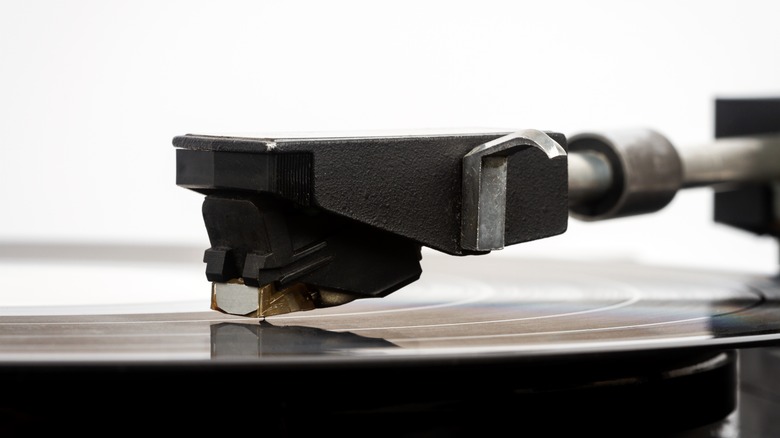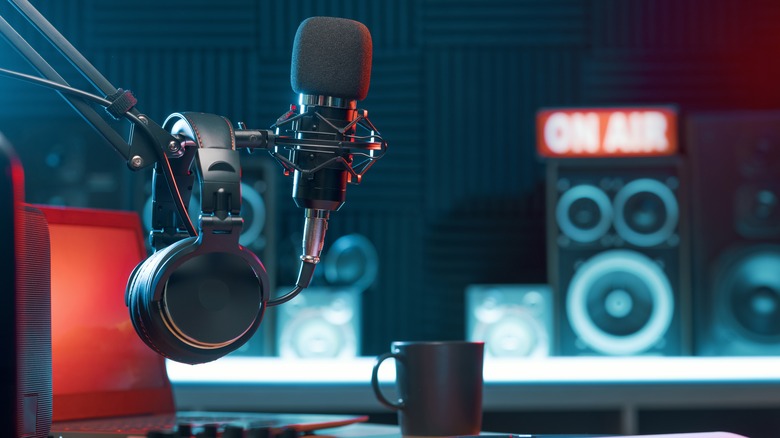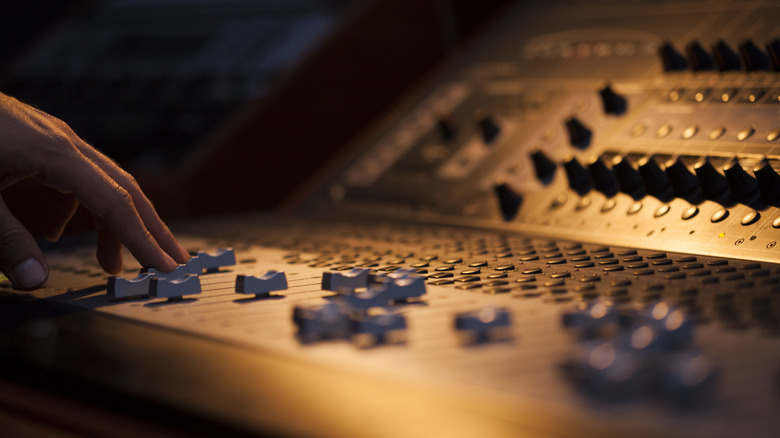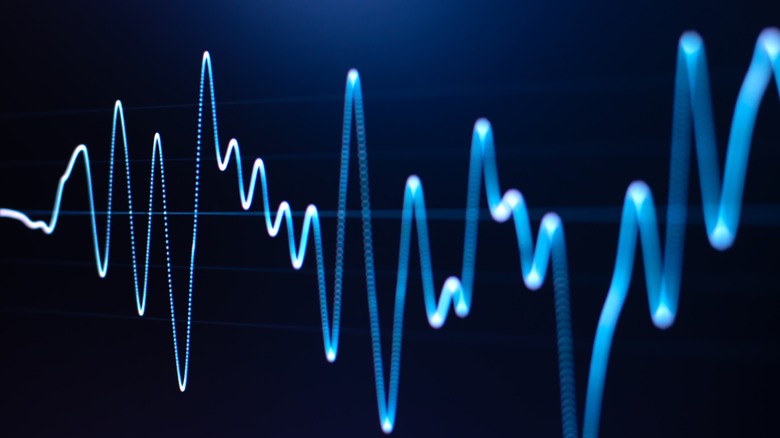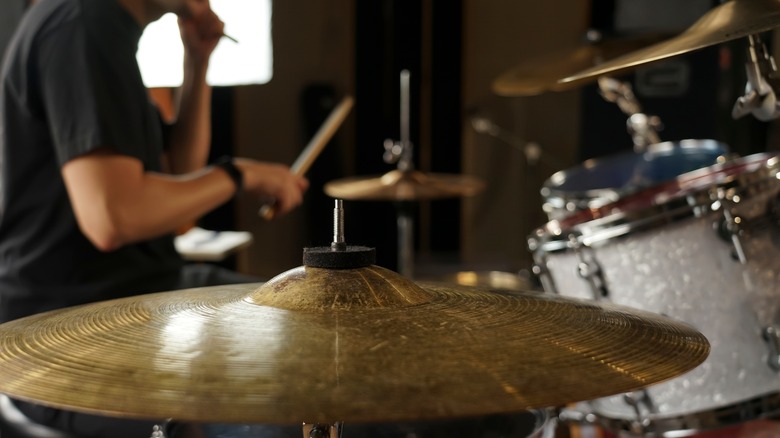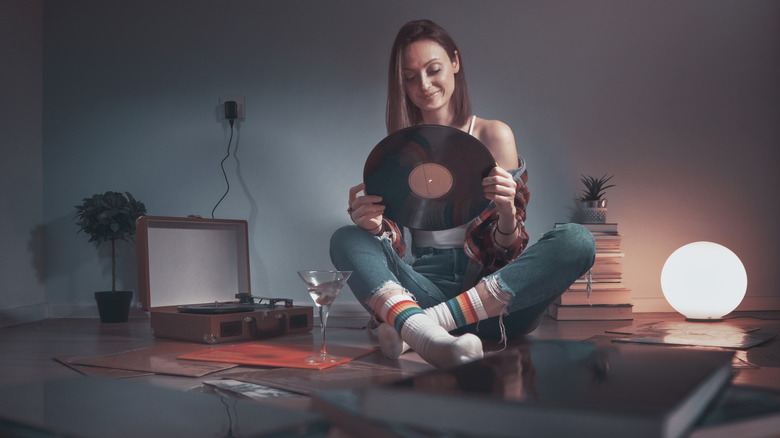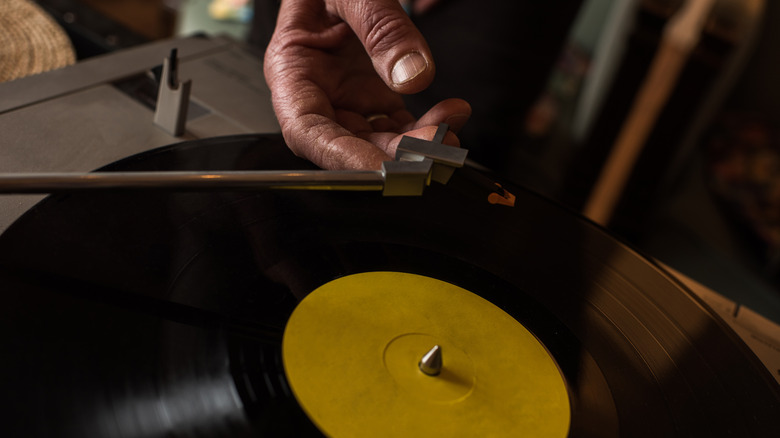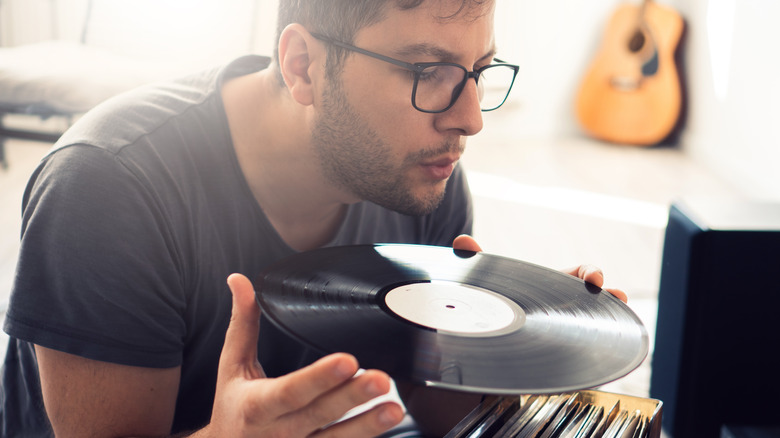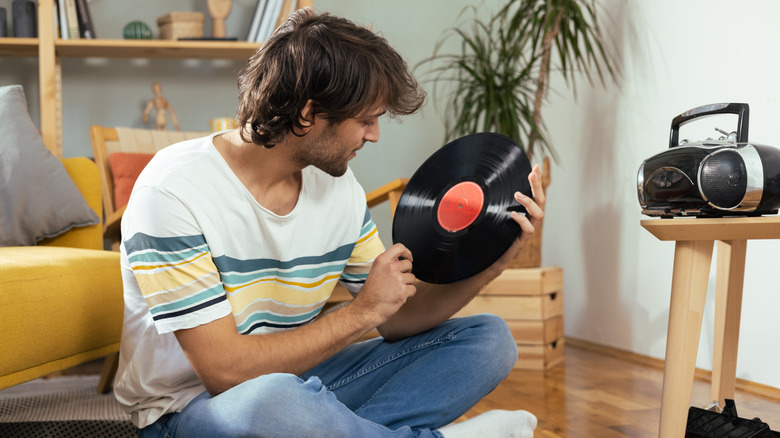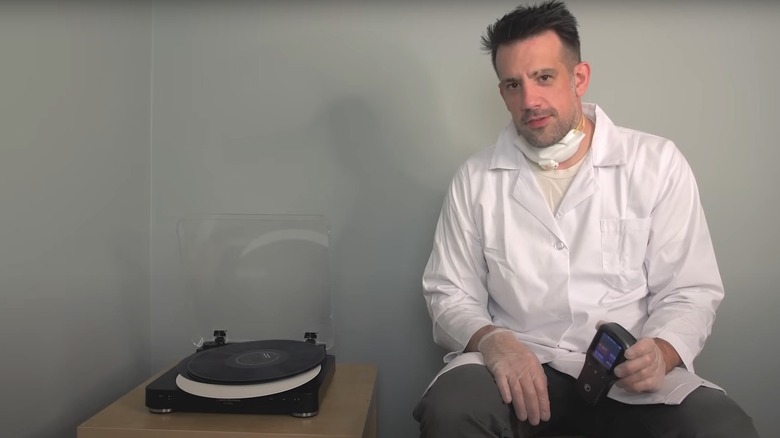Do Vinyl Records Actually Sound Better Than CDs? We Take A Closer Look
In 2017, something curious happened: Sony started manufacturing vinyl records again after ceasing all production in 1989. The RIAA's (Recording Industry Association of America) 2022 year-end revenue report explained why. Vinyl records made up 71% of physical media revenue that year and had outsold CDs for the first time since 1987, in addition to having 16 consecutive years of growth. And it isn't older generations fueling the record comeback, either. It's Gen Z learning how to operate turntables instead of rotary phones and cassette tape players. This may not be a return to vinyl's glory days; according to Statista, 2023 saw 43.3 million unit sales vs. almost 350 million in the late '70s. It's an impressive comeback nonetheless, especially for the audiophiles. After all, as many of them would tell you, vinyl is the superior listening medium. Spoiler alert: it's not, at least as far as fidelity is concerned.
For decades since CDs and digital audio became the dominant medium, a myth persists that vinyl is analog, and therefore music in its purest, unadulterated form. Like tapes and guitar amps, vinyl's analog music reproduction surpasses that of CDs (and digital audio, generally) every time — well, not quite. There are a lot of flies mixed into that particular ointment. Vinyls don't always overtake CDs in audio quality, and here are some reasons why.
Modern records are (almost always) recorded off digital masters
Vinyl's big selling point, some argue, is that it's analog from recording to release. There's no digital anything defiling those virgin musical notes; no digital microphones, no DACs, no computers, only analog sound waves etched directly into lacquer. That's almost never the case because most vinyl records are made with a digital master; masters, for reference, are the original, final, highest-quality version of the song used to make copies for other mediums.
It may seem like this is a new thing that only emerged prior to CDs in the 1980s, but that's sadly not the case. Digital recording goes way back to 1976 — for reference, the Rolling Stones were touring Europe that year. There is a very good chance that any record pressed after that date originates from a digital master. Digital audio eventually replaced every other aspect of the recording process, too, meaning vinyl might be the only truly analog link in the chain. Especially nowadays with modern artists (who record and produce entirely in digital) doing their own limited-edition vinyl runs.
This doesn't mean it's impossible to procure an untainted analog vinyl record, or its original analog master. In some rare cases, analog tapes exist of a song recorded in the pre-digital age. Also, a small minority of modern musicians choose to make some (or all) of their recordings on analog tapes, too. Even then, there's still a strong chance digital was used at some point in the pipeline before a song was cut to lacquer — such as mastering it in a DAW — which arguably sullies that analog purity.
Music has to be changed before being cut to lacquer
Ask anyone to describe what vinyl sounds like, and they will inevitably depict it as "warm," while digital audio is "cold "and "clinical." They say the warmth is because you're listening to the original, untainted sound of analog. But here's a difficult pill to swallow: that "warm" sound you're hearing is actually how a song has to be mastered (read: changed) to make it work with the vinyl medium's physical limitations — limitations that digital audio doesn't have.
For starters, sound engineers have to pan bass frequencies to the center (reducing them), otherwise the needle could experience tracking errors. Treble has to be managed, and high frequencies must be de-essed to prevent sibilance from causing distortion. Low-frequency music can't have too many high amplitude (loud) sections, or the needle with bounce and skip out of the groove. Further, tracks can't be as long, otherwise those tighter grooves could diminish sound quality. The record must also be mono-compatible, as stereo imaging is not as good (via Mastering the Mix). To make vinyl mixes sound their best, they require a special RIAA equalizing curve. This curve can be reversed with a turntable preamp, but the process does result in data being lost, and mastering already makes the recording less faithful from the get-go.
CDs, by way of comparison, don't have to make virtually any compromises, so the end result is a clean song that sounds as close to the original as you can get. Back in 1978, shortly after digital recording became the norm, sound engineers already deemed it superior, fidelity-wise, to analog vinyl. If you prefer that vinyl sound, you can just alter a digital recording to sound like it.
Vinyl has a narrower dynamic range compared to CDs
In simplest terms, dynamic range is the difference between the loudest and quietest sounds in a song; so, for example, it lets you distinguish whispered vocals from, say, a booming orchestral swell. Dynamic range goes hand in hand with the best listening experience. Top-of-the-line speakers like studio monitors for home recording can appreciate every sundry detail in a song that respects full acoustic breadth.
Vinyl's dynamic range, as you may have guessed by this section's title, is inferior to that of CDs, full stop. CDs can reach up to 96 dB of range, while vinyl records are stuck at about 70 dB. That may not seem like a lot on paper, but in practice, that's about 10 times the difference. Part of the reason this is the case is due to vinyl's "noise floor," which refers to the ambient sound of the needle scraping on PVC and the turntable's mechanical parts working. Noise floor tends to increase as the record and turntable age. Then there is "pre-echo," where sounds from a separate section of the vinyl get picked up before they play, particularly during a quiet section of a song.
A CD is perfectly silent during the quiet sections and can get plenty loud. The only advantage for vinyl records is that they tend not to be affected by the loudness wars, which spoiled many recordings starting in the '90s. This advantage only applies to physical songs made before the streaming era, since the loudness war was "lost" thanks to volume normalization.
Soundstage on vinyl is limited
If you thought that was bad, we are only just scratching the surface (pun intended). Yet another issue with vinyl is its limited soundstage. Soundstage, according to The Honest Audiophile, "reproduces an accurate portrayal of the recording setting." In other words, soundstage is what allows you to feel like you are present at the recording studio when the song was originally being committed to tape. You can hear where instruments are coming from in three-dimensional space, whether it's a drummer to your left or a guitar to your right.
We can achieve this thanks to left-and-right channel separation (a key to stereo audio), where the signal in each speaker (or headphone driver) is different. Good channel separation tricks our ears into thinking the music is right there in front of us. Sadly, vinyl has a more mono-oriented sound because of a slim 30 dB difference between both channels. CDs don't have this issue; channel separation goes up to 90 dB and beyond. In terms of immersion, digital audio wins the day.
Bass has some serious limitations on vinyl
We mentioned earlier that bass frequencies are reduced on vinyl, but the problem goes deeper than that (pun, again, intended). The issue with bass is not just that it can lead to needle skips, but that too much of it can "steal" from other frequencies; it takes up a of ton physical space in the groove, and it has to rob that limited real estate from, you guessed it, the higher frequencies.
Aside from tracking errors, the way bass can make the needle bounce out of the groove may cause other parts of the songs to literally vanish. Most of this never happens since, as we mentioned, the bass is centered. But that just means aspects of the music could get lost in mastering before it reaches your ears, even when reversing the RIAA curve.
Because of this, people who originally listened to a song on a vinyl record will sometimes hear a new level and depth of bass on CD. However, there are adjustments to make bass more present in vinyl. You can reposition your speakers, get a preamp, change cartridges and platters, or increase the needle tracking weight. Otherwise, just use CDs; the bass is 100% there already.
Some high frequencies don't register — or create distortion
High frequencies are another tricky subject when committing a mix to vinyl. We all learned in science class that lower frequencies, like bass, have long, stretched-out wavelengths. High frequencies like treble feature tighter, bunched-up peaks needed to produce the timbre of something like a high hat. As you can imagine, these grooves become incredibly tiny and fine on a vinyl record, making it very difficult for a needle to navigate through them at speed — or, in some cases, physically too small for a needle to fit into them at all.
The needle will then miss those pieces of the music entirely, and, in some cases, create distortion ewhen gliding over the peaks. Not only would you be missing those minuscule details in a song, distortion could be ruining the rest of the mix. These peaks are so problematic, in fact, that they can cause the machine cutting the lacquer to overheat, warping the vinyl and potentially creating distortion for all records made from the master stamper.
Another problem is that high-frequency sounds become even more difficult for the needle to track as the spin tightens closer to the center of the record. In general, high frequencies need enhancement to stand out on a record, unlike low frequencies. On CDs, high frequencies play identically to the original recordings.
Vinyl records degrade over time
Intuitively, it makes sense that vinyl records degrade ever so slightly as you listen to them. The stylus on a turntable is made out of diamond or sapphire, and scrapes along a comparatively soft PVC plastic. That scraping creates friction and heat that dislodges PVC material at a microscopic level. For reference, the needle itself wears out and requires replacement after as little as 500 hours of playing time, so imagine how the PVC is feeling after being played even just a few dozen times. Especially where it concerns those delicate details like high frequencies.
It's not just that teeny tiny wear and tear that's a factor, but the fact that PVC decomposes after about 1,000 years. A vinyl record will wear out over time even if it's been sitting quietly in its sleeve for decades. How fast does it wear down, though, and how big of an impact is there on the music? That's up for debate.
It depends on how well you care for your records, store them, and play them. It also depends on how well the record was made and the quality and condition of the turntable you play it on. It's probably safe to say most people aren't playing their vinyl often enough for wear to be an issue — and half of those who own records don't even have a turntable, anyway. CDs are easier to scratch, sure, but hundreds of plays on a well-treated CD won't impact the music quality — and you can always store digital files on more durable hard drives.
Turntables introduce wow and flutter
Turntables themselves present their own issues. They have to spin at a consistent rate to play music at the correct speed and pitch. Change that speed too much during a rotation, and you create "wow," where the song artificially speeds up or slows down once per rotation. "Flutter" is when vibrations from the turntable or the surrounding environment oscillate the tonearm (the stick with the needle that you place down on the record), causing a "fluttering" sound throughout the recording (via meemix).
You can hear both of these phenomena in action with this YouTube video from M. Zillch. Flutter sounds like that old-timey vinyl wavering effect. Wow is more of a sudden, sharp slowdown that gives off a horror movie-like vibe. No turntable is perfect, so you are bound to hear warped sounds like these occasionally in your own setup. CDs can produce glitched music, sure, but that's usually only because a CD is too scratched to be read correctly; a digital audio file already stored on your device will sound exactly the same every time you play it.
Dust and dirt create surface noise on vinyl
Nothing could be more iconic than a vinyl record's crackling and popping sounds. But as soothing and nostalgic as they may be, they're actually the byproduct of dust and dirt that has settled into the grooves. You may like that sound, but too much of it could be evidence you aren't keeping your records clean. If left without being brushed or blown off, that particulate matter could permanently damage the vinyl. The stylus could embed microscopic bits into the PVC, so the next time you play it, you'd hear a "pop;" the noise of the needle dislodging that particle and likely scarring your record (via The Sound of Vinyl).
Now, far be it from us to tell anyone there's something wrong with vinyl's idiosyncratic crackling sound. We'd bet money there's only a small minority that dislikes it. In terms of music fidelity, it is a strike against the medium in favor of CDs. Dust can definitely create issues with CDs and computers, but digital music files usually won't be suffering the consequences.
People may subjectively find digital better than vinyl
Vinyl may have a bevy of physical limitations against it, but at least people generally seem to prefer its warmth over digital audio's cold sterility, right? Perhaps not. One 2000 study by Bulletin of the Council for Research in Music Education in the University of Illinois Press made a series of identical recordings, then presented them to music major subjects in an A/B double-blind test on digital and vinyl. You'd think this would be the latter's time to shine, but it wasn't. Test subjects preferred digital every time. This would seem to suggest that listening to vinyl comes with additional psychological baggage that primes you to perceive it differently than it actually is.
One study is not the be all end all, sure, but it does at least suggest vinyl's not necessarily the king of audio. Vinyl isn't better because "it's analog, bro," and no one should feel they're getting a half-baked experience with their digital audio setup of choice. Studies aside, the medium you like is a matter of personal preference.
The verdict -- vinyl records or CDs?
Given everything we have discussed, it may seem like we are telling you to snap your vinyl records in half and throw your turntable out the window. Not so. Music is a highly personal, subjective experience. Everyone should listen to it the way they most enjoy it, period — and that means vinyl evangelists ought to cease telling digital music users they're selling their ears short. If someone likes their old CD folder collection, leave them be.
Still, more people listen to vinyl records than CDs, and for good reason. It's a vintage, nostalgic means of experiencing music. Nothing beats pulling an old record out of a paper sleeve, setting it down on the platter, and easing the needle into place. Vinyl sets the mood for romantic dinners or slow evenings better than Apple Music and Spotify, some might argue. The vinyl sound, regardless of the fact that it's a result of its physical limitations, may just be to someone's tonal liking. If you prefer vinyl, by all means, listen to it — and if you like your Bluetooth headphones for listening to CD-quality rips, you aren't doing anything wrong.
Vinyl's health risks
Before you listen to vinyl with abandon, be aware of its other issues. PVC (like plastics in general) is derived from petrochemicals that contribute to climate change — something we need to reverse post-haste. Plus, vinyl compound comes from an under-regulated industry that exposes workers to toxic fumes and creates equally toxic runoff, according to The Guardian. Companies have developed ways to make vinyl safe and green, but it'll take time to get all record-making companies to use it.
Then there's vinyl's health effects. PVC is carcinogenic, causes damage to nerves and reproductive organs, and often contains additives like lead and cadmium. It exhibits a lifelong, chemical breakdown (known as outgassing) that spits out vinyl chlorides, turning turn your body into a magnet for persistent organic pollutants (POPs). Agent Orange is one glaring example of POPs. Musician Benn Jordan tested his own vinyl with an industrial-grade air quality monitor to see just how bad this effect is. Playing newer records for just a couple of minutes led to a sharp rise in unsafe air quality; playing older, more worn vintage records caused the same unsafe levels within moments of setting the record on the platter; shuffling through records (without playing them) led to levels unsafe for short-term inhalation. This was with a handful of records; imagine a shop (or home storage cabinet) full of them.
To be clear, Benn Jordan admits he's not a scientist, and his testing was primarily for curiosity's sake. His methodology may have limitations and confounding variables. Regardless, the science behind PVC outgassing is rock-solid. The test results should at least make vinyl owners think twice. Try to source non-PVC vinyl, if at all possible, for the health of you and your loved ones.
